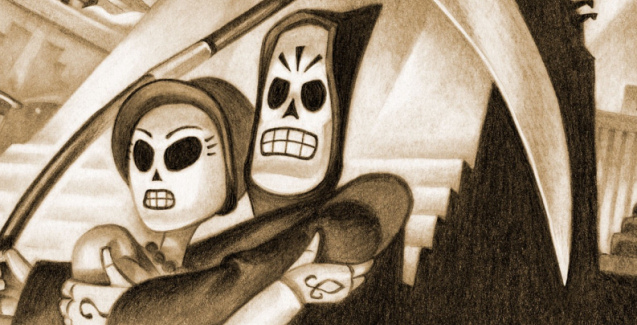How Adventure Classic Grim Fandango Holds Up 16 Years Later
All that critical acclaim is intimidating.

For a game 16 years old, it’s hard to see the cracks in its bones. It’s a classic for a reason. But what bugs me about Grim is what bothers a lot of people about adventure games: the puzzles you spend way too much time trying to solve.
I admit: I cheated more than I would have liked on Year 2, which felt like the largest area in the game, with many different characters to talk to and places to go. (I sort of cracked down on myself after that.) That made figuring out what to do with the items I collected even more confusing. Years 1, 3, and 4 were more self-contained and easier to beat on my own, but that doesn’t mean I wasn’t pulling my hair out at times—with or without the walkthrough.
Occasionally, I would get stumped because a room or corridor was difficult to spot or access. When a game tells me that “there’s nothing but dark water in that direction,” I trust that there’s nothing at the end of the screen. The game lied.
Head-tracking is a great feature even today, but Grim‘s new analog controls aren’t always subtle enough to keep up with it. Sometimes it’s easy to see Object A and Object C but not to detect Object B in between. So you’ll fiddle around looking at something and jam the examine button until you finally get a different result. (This happened to me when I was defusing a bomb, and in other instances as well.) By then, you probably missed it and moved on, only to suffer torment later when you finally discover that it was RIGHT THERE.
Another thing. Not that this is Grim‘s fault per se, but I lost about an hour’s progress because the PS Vita version kept encountering an error and crashing on me. There’s no auto-save, and saving the game is a sloowww process. I don’t know that this was a necessary aspect to keep to preserve the original game. I mean, we live in 2015, for crying out loud!
Some of the animations you’re forced to watch are slow and unskippable, like lowering and raising the anchor in Year 3. (Oh, how I wanted to die.) But worse is trying to drive Glottis’s car with tank controls in the Petrified Forest and operating a forklift in an elevator, which … isn’t even natural. These moments are painful. Tank controls are not as wonderful as developers used to think they were.
But the most frustrating part to me wasn’t even the occasionally unintuitive puzzles, based on logic that qualifies them for those “worst adventure game puzzles” lists: like showing a VIP pass to Glottis when I would have no reason to, or knowing what date to print a betting ticket based on a random thing somebody mentioned.
No, the worst were the puzzles that would only trigger after I met qualifications that I could never know about. In Year 3, there’s a scene where you smoke a cigarette and swivel the ashtray toward you to tap in the ashes. Then you swivel it back. I kept triggering this scene—mostly by accident (and this is an example of those animations you have to sit through and can’t skip)—and knew there was something special about it, but nothing happened. That is, until I reached a point in the story where the game decided the same animation would give me a new result: The other character using the ashtray would miss and burn herself instead.
It would make sense if I found an item that I could use to steer the scene in a new direction, or if I gained a new piece of information. But there was no reason as far as I could tell why I couldn’t have triggered that scene an hour before. (I had even heard Chepito talk about stockings as a barter item.) So I was left running around confused until I finally tried it again, at just the right time. Whatever that time was.
Adventure games can be bullshit, man.
Complaints aside—because let’s face it, a hell of a lot of adventure games are annoying to some degree, and we love them anyway—Grim Fandango is a classic for a reason. Some elements might be a little worse for wear, but it plays more like a modern game than one released 16 years ago. And for that extra coat of polish, Double Fine has remastered the graphics and lighting (though you can still play with the original assets) and added in extras like director’s commentary that you can listen to as you play.
I wasn’t whisked away by the story, characters, or puzzles in the way I wanted to be, but that doesn’t mean I don’t admire what Grim Fandango is and what it accomplished. I recommend it just to get a taste of that little piece of history.
But if you don’t fall in love with it, here’s one person who won’t judge you, amigo.
Did you play Grim Fandango in 1998, or are you as new to it as I am? What makes it special for you?
Stephanie Carmichael writes about video games, comics, and books when she’s not helping teachers and students have fun together with Classcraft, an educational RPG. Find her on her blog or on Twitter.
Are you following The Mary Sue on Twitter, Facebook, Tumblr, Pinterest, & Google +?
Pages: 1 2
Have a tip we should know? tips@themarysue.com